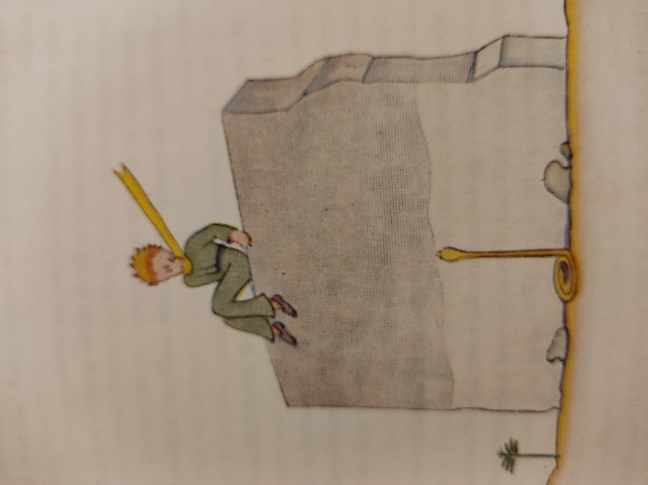Contelui Antoine Jean-Baptiste Marie Roger de Saint-Exupéry, romancier de succes și aviator ghinionist i se propune – în 1942, pe când se afla în America de nord - scrierea unei cărți pentru copii cu ocazia sărbătorilor de Crăciun și a noului an. Rezultatul va fi « Micul Prinț / Le petit Prince », un fel de biblie pentru folosința purilor copii.
Ne putem închipui că micul prinț este un fel de fata morgana pe care Antoine de Saint-Exupéry o zăreste în deșertul african unde se prăbușise avionul pe care îl pilota, un alter-ego liric al autorului.
Ni-l putem închipui pe micul prinț și ca pe un nou Isus care, exasperat de micimea lumii păcătoase a « oamenilor mari / les grands personnes », vrea să arate adevărata cale a izbăvirii. Îl putem privi și ca pe un egocentric caruia îi este greu să se desprindă de planeta sa, de micii vulcani ce trbuie curatati periodic, de floarea sa. Micul prinț întruchipează un personaj solitar, melancolic, mirat și dezămagit de întălnirile sale inițiatice cu ființele, plantele și geografia asteroizilor vizitați. El cauta prietenia, empatia, armonia (universală ?) Situându-ne în acest registru - să zicem mai terre-à-terre - micul prinț poate fi privit ca un copilaș totodata și naiv și curios și răzgâiat - vrea o oaie (Isus mielul lui Dumnezeu, sacrificiul suprem ?) dar cu botniță pentru a o împiedica să-i manânce floarea - dar, mai ales, anxios depresiv. Dezamăgit de experiențele asteroidale și pământesti el se ridică la ceruri întorcându-se / sinucigându-se (sarpele galben !) pentru a-și proteja floarea vs-à-vis de păcătoasa lume.
*
Niște arhitecți care – să presupunem – au « cei șapte ani de acasă », au citit « Micul Prinț », Biblia și cateva alte scrieri, au privit cerul înstelat, mările, oceanele și munții, au ascultat vuietul vantului, cântul păsărilor sau urletul lupului, au vorbit cu bunicii, părinții, vecinii, cu prietenii și cu dușmanii, vor fi aceia care au priceput că « vedem bine doar cu inima, esențialul rămânând invizibil ochilor ». Și acestor arhitecți le va fi probabil extrem de dificil să răspundă dorințelor clienților autoritari, vanitoși, vicioși, afaceriști, alienați, mărginiți, care au ajuns cu toții - părăsind asteroizii pe unde sălășuiau în povestea micului prinț – pe sfera pământească.
Dar – presupunem iar – cunoscând acești arhitecți istoria meseriei lor, din cele mai vechi timpuri până-n zilele noastre, și-au zis : « Dacă noi nu, atunci cine ? Alți arhitecti ? Pentru aceiași, din totdeauna la fel « alcătuiți », clienți ? ». Faraonii dornici de piramide, sfinții papi, cardinali și regi imaginând marețe catedrale și-ntinse palate și grădini. Sau Lenin declanșând (prin ricoșeu « revoluționar ») mișcarea constructivistă. Sau Mussolini naș (printre altele !) și al raționalismului italian. Sau – printre alți miliardari – Arnault și fundația sa, sau – printre alți dictatori – Heydar (tată) si Ilham (fiu) Aliyev. Așa se scrie istoria arhitecturii. Și așa se întâmplă ca arhitectul, dacă vrea să existe va pune mâna pe creion sau/și clavier și va face ce trebuie făcut : proiectul comandat de client.
Puținii încăpățânați, circumscriși ariei unei oneste ingenuități mic princiare – les grandes personnes sont décidément très très bizarres - vor refuza (probabil ?) complicata și dezonoranta « colaborare » cu asemenea clienți. Se vor refugia (poate ?) în activități conexe, vor deveni « experți » în largi colective unde responsabilitatea devine difuză, sau vor « aluneca » în virtual. Imaginând spații, forme, geometrii, trasee nicăieri așezate și de nimeni dorite. Așteptând clientul & momentul când clădirea se va putea așeza, în « liniște », pe locul ei. Vor fi nemulțumiți, angoasați, uneori deprimați ? Sau vor fi mulțumiți, relaxați, uneori fericiți ?
Numai galbenul șarpe din deșert ne poate spune…
*
« Cred că arhitectura a fost o profesie, poate pâna în anii ’70 ai secolului trecut, când întrebați ‘’putem face ceva’’, orice arhitect putea spune ‘’da, putem face acest lucru, putem face asta’’. Dar cred că de atunci ceva ne-a fost luat și ceea ce ne-a fost luat cred că se datorează modului în care – fie în China, Rusia, Europa sau America – am considerat economia de piață ca fiind vocea finală despre orice și, prin urmare, această întreagă legatură cu cunoașterea procedeelor sau cu știința facerii a fost eliminată, aș zice, din repertoriul unui arhitect… Poate că nu este așa de trist…deoarece cred că istoria arhitecturii este și istoria unei serii de ambiții incredibil de iresponsabile. » Rem Koolhaas – interviu, Strelka Magazin, 2018.
*
Am aflat - din surse sigure, verificate - că micul prinț a mai vizitat un asteroid unde vanitatea, mercantilismul, viciul, indiferența coexistau în bună pace. Cu putere afirmate, înșelător justificate. Printre locuitorii acestui asteorid se aflau Z. Hadid, F. Gehry, W. Prix, R. Schumacher, D. Libeskind si alți câțiva dintre epigonii lor, mai puțin vestiți și nu tot atât de « înzestrați ». Atât de surprins și dezamăgit fu micul prinț încât nici nu a mai vrut să-l întristeze și pe prietenul său deșertic, Antoine, cu încă o tristă poveste.
Aceste câteva ultime rânduri au rolul de a evidenția faptul că micul prinț continuă să călătorească din asteroid în asteroid facand și scurte vizite pământene.
Să fim atenți, poate-l vom întâlni !


